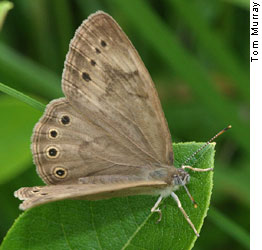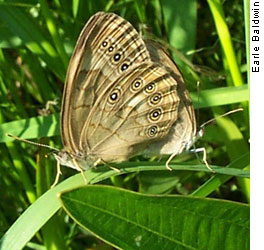Butterfly Atlas
Find a Butterfly
Eyed Brown
Satyrodes eurydice
Named
Johansson, 1763

Taxonomy & Nomenclature
See Appalachian Brown
Identification
Wingspan: 1 5/8-2". Differentiating Eyed Brown from its sibling species Appalachian Brown, S. appalachia, is not always easy. Both species are medium sized, tan butterflies with numerous eyespots on all wing surfaces. Typical Eyed Browns can be separated from typical Appalachian Browns by inspecting the underwings. The postmedian line on the hindwing below in S. eurydice normally shows one or more deep indentations, particularly along the lower third, while S. appalachia presents a more subtle wavy line. The hindwing post-basal line (the one nearest the base of the wing) is also useful in that it shows a sharp indent near the upper portion for Eyed Brown and is straight overall in S. appalachia. The submarginal eyespots on the forewing are more or less equal in size in eurydice and unequal in appalachia. Some specimens collected during the Atlas period, however, proved difficult to assign to one or the other species based on this character. Scott (1986) refers to some evidence for hybridization around New York City; a similar situation might be occurring in the Northeast in general and thus account for individuals displaying intermediate characters. See also Habitat.
Distribution
Southeastern Saskatchewan east through the southern sections of the Canadian prairie provinces to the Maritimes and from the Dakotas and Nebraska east through Minnesota, the Great Lakes Region, northern Pennsylvania, and New Jersey. Throughout New England.
Status in Massachusetts
This is a fairly common to locally common species in the state although Atlas data indicate that it is scarce or absent from southeastern Massachusetts including the Cape and islands. Several sites were located for this species, however, on the western side of Buzzards Bay. Maximum: 19, 10 July 1994, Wrentham (Norfolk Co.).

Flight Period in Massachusetts
One flight: late June to early August. Extreme dates: 22 June 1994, Granby (Hampshire Co.), T. Fowler and 23 August 1993, Stockbridge (Berkshire Co.), P. Weatherbee.
Larval Food Plants
Sedges including the widepread tassock-sedge (Carex stricta), as well as C. bromoides, C. lacustris, C. lupulina, C. trichocarpa, and C. utnculata, . (Scott, 1986).
Adult Food sources
Found once at Swamp Milkweed, but like other satynds, prefers sap, rotting fruit or dung, including bird droppings.

Habitat
Wetlands, especially sedge meadows and cattail marshes. Several authorities make reference to the fact that this species differs from S. appalachia in that the latter occurs in wooded swamps while S. eurydice haunts open sedge meadows. While this is generally correct, the two species are often found in close association as their habitats often overlap.
Life Cycle
EGG: Pale green; dome shaped and smooth. OVIPOSITION: Eggs are laid singly and apparently not always on the host plant. LARVA: Bright green with various yellow and green lateral stripes and a pair of red horn like protuberances on the head — the red extending onto the head and a similar pair of horns at the tail. CHRYSALIS: Green with a dorsal stripe and some buff highlights. OVERWINTERING STAGE: late instar larva.
During July adults are often observed perched in their favored habitat. Although Eyed Browns‘ flight is somewhat tentative, they make good use of the available cover by weaving in and out of the grasses and sedges. This insect overwinters in the third or fourth larval stage. In spring, development proceeds with the first adults emerging from the pupal stage in late June.
Account Author
Richard K. Walton



